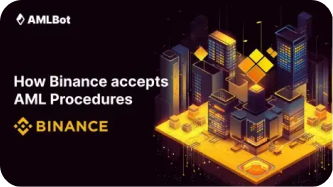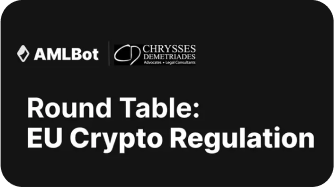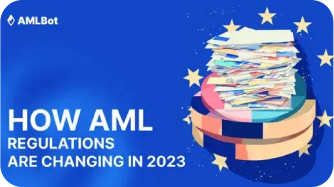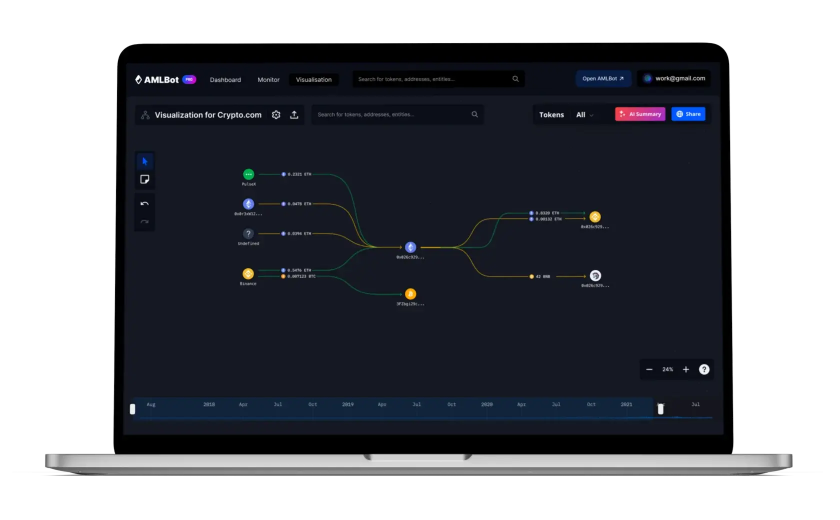+$100 000 000
Amount of the risky funds
detected



Compliance departments
that accept our AML
procedures
60,000+
Service providers checked
Our initiatives
More in our blog

Jun 16, 2024 · 2 min read
How to Open a Financial
Institution Account at
Binance
How to Open a Financial Institution
Account at Binance If You Are a Crypto...

Jun 9, 2024 · 1 min read
AMLBot Team Attends EU
Crypto Regulation Round
Table
With the application of the Markets in
Crypto Assets (MiCA) on the horizon...

May 14, 2024 · 7 min read
How AML Regulations Are
Changing in 2024
With the application of the Markets in
Crypto Assets (MiCA) on the horizon...

Jun 16, 2024 · 2 min read
AMLBot Team Attends The
Web3 Euro Summit 2024
At AMLBot, we constantly strive to connect br with projects and ...








AMLBot’s services
We provide full pack of options for safe work with crypto
screening
empower AML
compliance tools within
your current system. All
transactions are
automatically verified to
comply with AML and
FATF requirements and
reduce your business risk
exposure.

automated verification
process empowers your
business to swiftly
onboard customers,
reducing manual effort
and mitigating identity fraud and illicit activity
risks.

procedures
venture with ease,
simplicity, and
confidence through our
streamlined AML and
KYC consulting, ensuring
smooth compliance and
effective risk
management right from
the beginning.

accounts
at CEX/EMI
account opening on CEX
EMI with our expert
assistance, ensuring your
focus remains on
business growth in the
crypto industry.

investigations
cryptocurrencies with
AMLBot's expert
blockchain
investigations, swiftly
identifying culprits and
tracing funds for
effective recovery.

Spending a few dollars on a check may save you a large sum.

for each client.
crypto enterprises of all sizes in 25 jurisdictions.

more for crypto businesses.
sources, ensuring that we have the most reliable
data in the industry.
streamline your company processes, removing
compliance provider complexity.

significance of fast, friendly
customer support, thus we're
always here for our clients. 24/7
support.
An answer during the night may take a bit longer


Co-Founder
Slava Demchuk


Blockchain Analyst
Sid Panda

Certified AML Specialist
Graeme Hampton

Head of Investigations
Anmol Jain
the list?
touch 24/7, so any issue can be
resolved quickly and in a live chat
format.

We're in messenger
We will answer within 30 seconds
FAQs
What does the address check show?
The overall risk (percentage) is the probability that the address is associated with illegal activity. The sources of risk are the known types of services with which the address has interacted and the percentage of funds accepted from / given to these services for which the overall risk is calculated.
What do the parameters in the check results mean?
AMLBot checks the specified wallet address for connections to known blockchain services. AMLBot conventionally groups these services into groups with different levels of risk of illegal activity. The check shows the connections of the checked address to these groups as a percentage. Based on all the links, an average risk score is given, which helps the user to make further decisions about the assets.
How do I understand risk assessment?
Each client determines for himself what percentage of risk is
acceptable for him. Conventionally, the risk score can be divided as
follows:
- 0-25% is a clean wallet/transaction;
- 25-75% is the average level of risk;
- 75%+ such a wallet/transaction is considered risky.
It is also worth paying attention to the red sources of risk in the detailed analysis, described in page
How quickly is the balance replenished?
After transaction confirmation, the balance is replenished:
• up to 10 minutes if payment was made within 24 hours after the
invoice was issued,
• up to 25 minutes if payment was made after 24 hours after the
invoice issuance. Overall, BTC, ETH, USDT, and fiat are processed
faster than other coins.
What does the percentage risk score mean?
AMLBot finds links of a verified address to different users in the blockchain, each with a different conditional risk score.
The overall risk score is the average of all the components found. For example, if out of 2 BTC on the wallet being checked, 1 BTC came from mining (0% risk) and another 1 BTC from Darknet (100% risk), the risk score would be 50%.
How does AMLBot help to protect you against blocking?
By checking counterparties' wallets before a transaction, you can reject their assets if the risk score is high. Also, before transferring funds to other services, you can check your wallet address and save the result (make a screenshot).
If the check shows that your assets had no connection with illegal activity and the service blocked you, you can provide the saved result to confirm the purity of your assets.
The risk is higher than 50%, but I am certain that the address is reliable. What to do?
The verification results are based on international databases, which are constantly updated. So an address that had 0% risk yesterday may have received or given the asset to a risky counterparty today. In this case, the risk score will change. If you want to be sure of the result and determine what the cause of the high risk is, we can do a detailed check for you. To do so, email us at [email protected]
What is the difference between an address and transaction checks?
Address (wallet) check is an analysis of all addresses ever associated with it, from which funds were received and to which funds were sent. Check transaction (you need to specify TxID) and then you select:
- I received the funds (Recipient) and the address to which the funds were received (Deposit). In this case, the addresses from which the funds were received are checked. If you look at a transaction in the blockchain explorer, these are the addresses on the left and everyone they interacted with before the transaction.
— - I sent the funds (Sender) and the address to which the funds were sent to (Withdrawal). In this case, the wallet that received the funds is checked (it is on the right in the blockchain explorer), as well as all its connections before this transaction. Thus, when checking TxID, the risks for the recipient are checked if you choose receiving funds, and the risks for the sender if you choose sending funds.
What happens if I don't use all my checks each month?
They stay within your account, and you can use them at any time.
How often are checks recommended to do?
An answer to this depends on your unique risk model. The general recommendation would be to perform an AML check every time you interact with an unknown wallet or a smart contract.
What cryptocurrencies does AMLBot analyze?
AMLBot supports all major blockchains and tokens on them. We are constantly adding support for additional cryptocurrencies. You can always check the up-to-date list of supported cryptocurrencies in web dashboard or in API Documentation .
What if I will need more checks?
You can buy additional checks as needed. The number of checks is always displayed within your user information.
Sign in
Log-in to your account
Sign Up!
Sign up
Log-in to your account
Sign in!






























 Telegram
Telegram Reddit
Reddit LinkedIn
LinkedIn Twitter
Twitter Medium
Medium YouTube
YouTube TikTok
TikTok